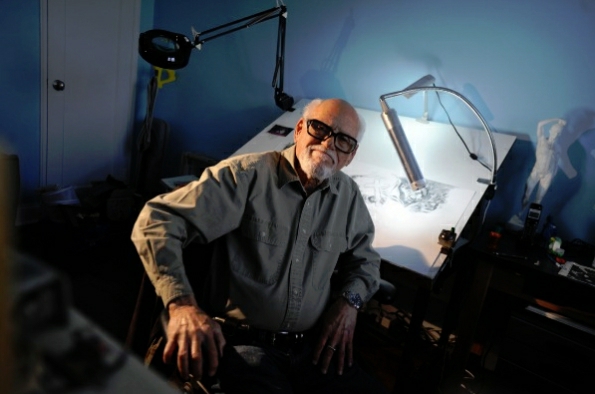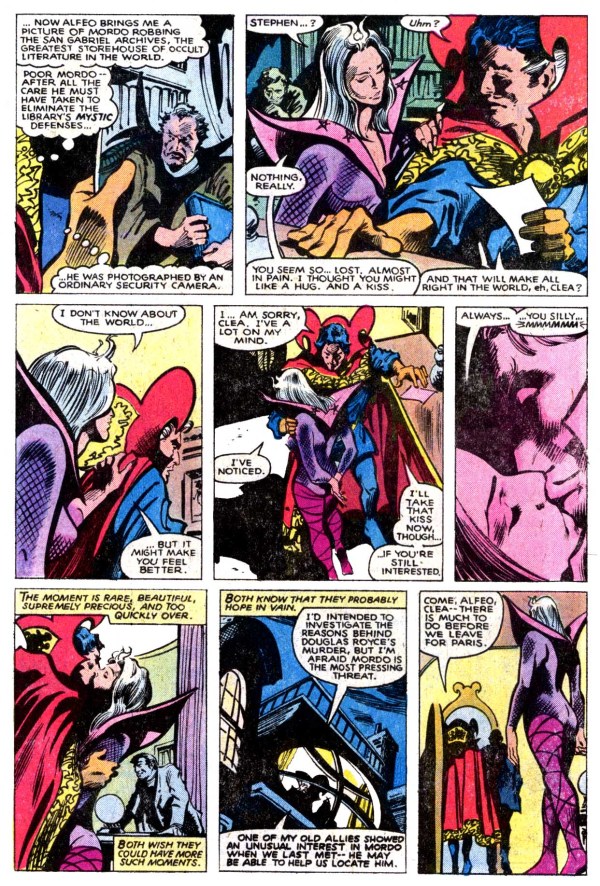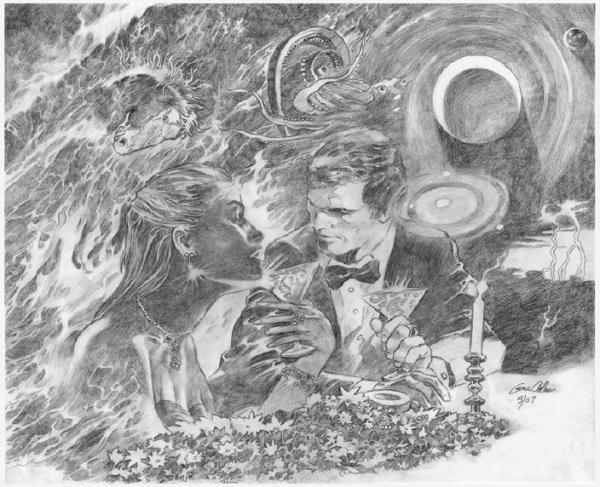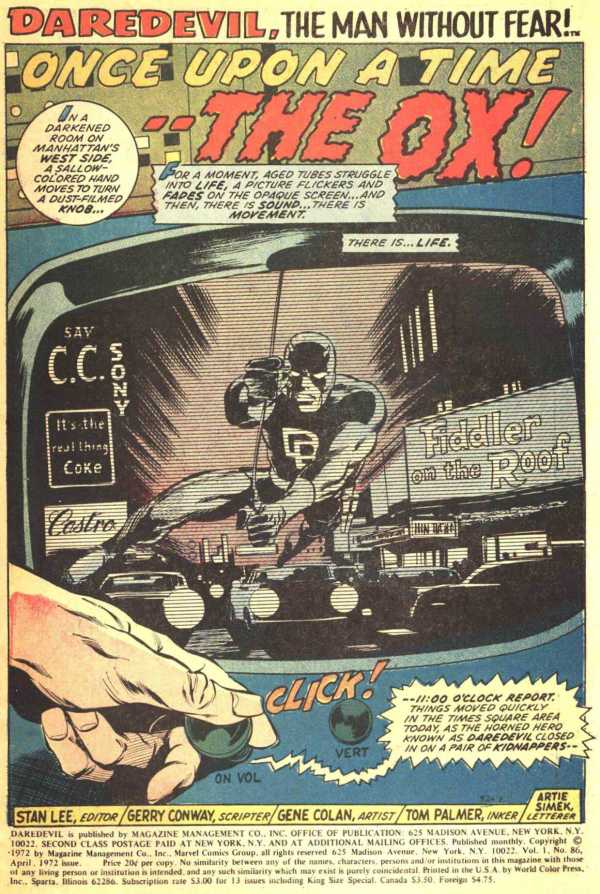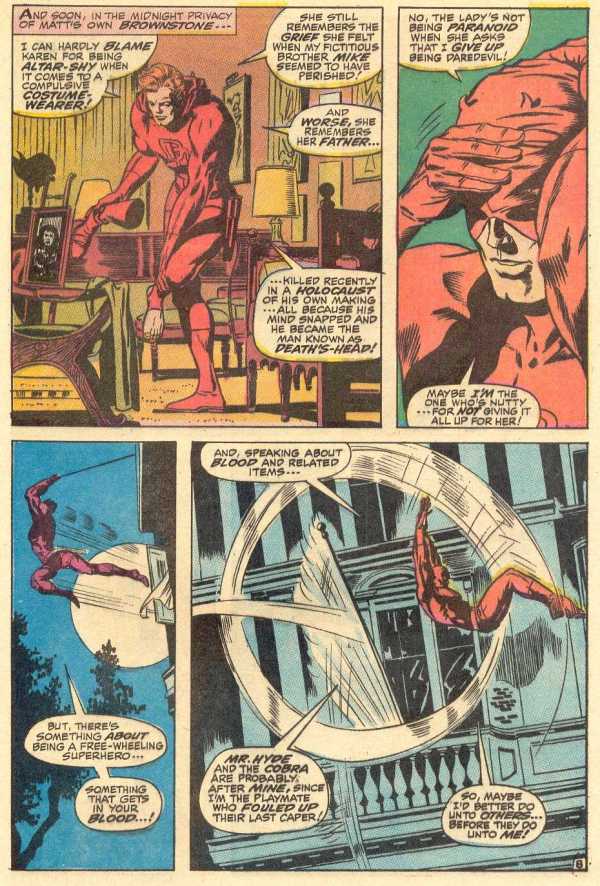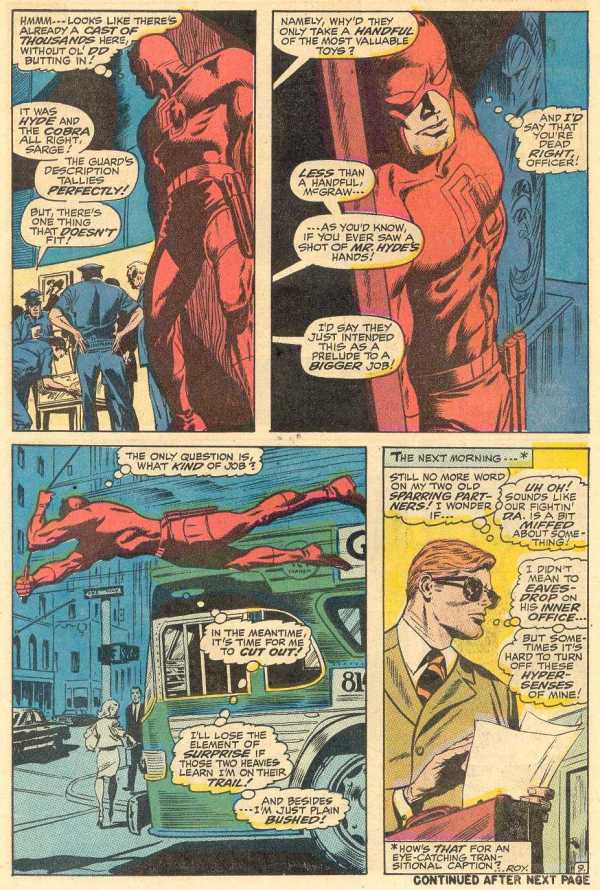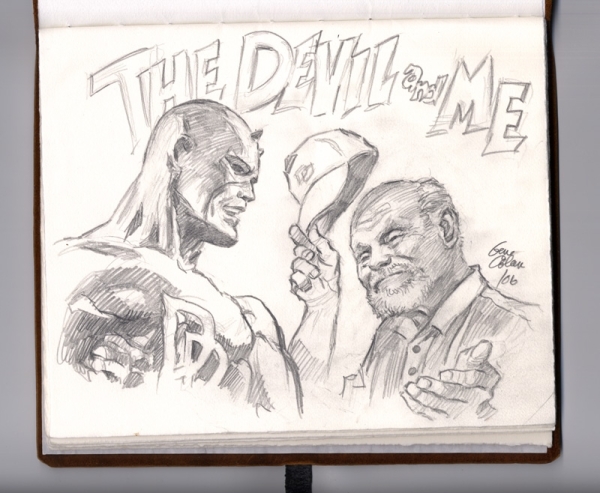Legendary artist and gentleman Gene Colan, 84, whose career in comics spanned seven decades and included definitive work on many popular characters, including Dracula, Daredevil, Dr. Strange, and Howard the Duck, died Thursday 23 June 2011 at about 11:00 pm at Calvary Hospital in the Bronx from complications of liver disease and cancer. A private funeral will be held on Sunday. In lieu of flowers, the family has asked that Colan’s friends and admirers consider a donation to the new Gene Colan Scholarship at the Joe Kubert School.
FORMAL OBITUARIES:
The Beat > Gene Colan 1926-2011 by Heidi MacDonald
Comic Book Resources > Remembering Gene Colan by George Khoury. Here’s an excerpt:
It was at Marvel that the artist’s work really began to blossom to its fullest potential. Via the Marvel Method of creating comics, the artist was allowed to compose and direct the stories in the manner that he saw fit (and a writer later scripted the drawn pages) — in his imagination, the conceivable was always achievable. Colan orchestrated action flawlessly and never let the comic art board intimidate him. Those that looked at the quality of his stories in “Daredevil” or “Sub-Mariner” saw a bold artist that brought his heroes to life in true cinematic fashion, equipped with a camera that conveyed the grand movement and power of the Marvel Heroes. His stylized technique and craftsmanship were the strengths that Colan would pass on to his readers in everything he did.
Deseret News > Comic book artist Gene Colan dies at 84 by Ula Ilnytzky, Associated Press
news from me > Gene Colan, R.I.P. by Mark Evanier. Here’s an excerpt:
As a reader, I loved Gene’s work. There was a credibility about it: No matter how outlandish the premise or plot, Gene somehow made you believe it. His pencil art was magnificent…in many ways, too good for the assembly line production process and the flimsy printing that it usually received. As good as his work looked in your comics, it was always probably better.
I later got to love Gene. He was a charming, self-effacing gentleman who was genuinely moved when fans tried to tell him how good he was and how much joy his work had given them. He heard that a lot and remained utterly unspoiled by all the praise. In a way, it seemed to make him try harder to improve his drawing and live up to what they said he was.
The New York Times > Gene Colan, Prolific Comic-Book Artist, Dies at 84 by Margalit Fox. Here’s an excerpt:
Mr. Colan’s work was noteworthy on several counts. The first was its sheer duration: He completed his first professional assignment in the 1940s and his last a year or two ago. In between, his art was a mainstay of the Silver Age of comics, as the period from the mid-1950s to about 1970 — a time of heady artistic ferment in the field — is known.
The second was its prodigious volume: Over nearly seven decades he illustrated many hundreds of comics, from the famous, including Batman, Wonder Woman and the Hulk, to the possibly less so, including Ben Casey, Falling in Love and Captain Britain.
The third was his visual style, by all accounts unlike that of any other artist in the business. Where comic-book art tends toward deliberately flat, stylized images, Mr. Colan preferred a realistic look that emphasized texture and fluidity: the drape of a hero’s cape, tilt of a head, the arc of an oncoming fist.
A lifelong film buff, Mr. Colan was known as a master of light and shadow, which lent his work a noirish, cinematic quality.
TCJ.com > Gene Colan, 1926-2011: “For Me, It’s A Ride That Didn’t Enter My Mind Would Ever Happen.” by Tom Field. Here’s an excerpt:
[…] Gene Colan never would be mistaken for anything less than what he was: One of comics’ unique stylists. He wielded his pencil like a brush to capture the toned subtleties of action, emotion and lighting. He brought a cinematographer’s vision to comics storytelling, and his stories were instantly recognized by fans, treasured by scholars and appreciated enviously by even his most accomplished peers.
While delighting his fans, Colan often frustrated his writers. He was notorious for never reading scripts in advance, so he often ran out of pages before drawing the end of the story. Meanwhile, he would devote half a page to a hand turning a doorknob, or three pages to Captain America merely walking down a street. His indulgences were accepted in the 1960s, when Lee put the artists in charge of pacing the stories. But Colan encountered resistance in the 1970s, when the writers gained influence, and especially in the 1980s, when the editors seized control.
Ultimately, he outgrew his inkers, who always struggled to delineate Colan’s complex penciled drawings. By the 1980s, Colan’s penciling style and printing technology were so refined that, starting with Dean Mullaney at Eclipse Comics, publishers skipped the traditional inking stage and started reproducing Colan’s textured work straight from his pencils, starting with writer Don McGregor’s Ragamuffins and Nathaniel Dusk. Once Mullaney opened this door, printing from Colan’s pencils became the default for the next 20-plus years. Even at the end of his career – Colan’s final feature-length story was a 2009 issue of Captain America – Marvel produced two editions, one in color and the other in black-and-white, so fans could appreciate the pure beauty of Colan’s pencils.
No one could or likely ever will draw quite like Gene Colan.
NOTICES AND TRIBUTES:
artdaily.org > Subtle and Emotional Comic Book Artist Gene Colan Dies at 84 in the Bronx by Matt Moore, Associated Press, and Ula IlnytZky, Associated Press
Atomic Pulp and Other Meltdowns > R.I.P Gene Colan by Christopher Mills
A.V. Club > R.I.P. Gene Colan, comic-book artist by Jason Heller
The Beat > Remembering Gene Colan by Heidi MacDonald
The Best Damn Creative Writing Blog > Gene Colan is Dead by Rob Vollmar. Here’s an excerpt:
Across the seven decades that Gene Colan contributed to comics, a lot of artistic styles came and went. Though Colan developed his style actively across that span, the progression was always towards a more refined version of himself. Artists that were more easily mimicked may have been more influential but Colan’s style was irreduceable and didn’t lend itself to swiping. If you wanted comics the way he drew them, you had to go to the source. His layouts were dynamic and could described as filmic without limiting either the influence of film or denigrating the potential of comics.
Big Shiny Robot > In Memoriam: Gene Colan 1926-2011 by Androidika
Bleeding Cool > Legendary Comic Book Artist Gene Colan Has Died by Mark Seifert
Blog into Mystery > A personal tribute to Gene Colan – Detective Comics #556 by Jared M.
BobGreenberger.com > Gene Colan, R.I.P. by Bob Greenberger
Broken Frontier > R.I.P. Gene Colan (1926-2011) by VashNL
Brutal as Hell > RIP Gene Colan, Co-creator of Blade by Ben Bussey
CBR > A Friday Memorial to a Master by Greg Hatcher
ComicBook.com > Gene Colan, Legendary Comic Book Artist, Dies at 84 by Nick Winstead
Comics Alliance > Celebrated Comics Artist Gene Colan Passes Away at 84 by Caleb Goellner
Comic Vine > Gene Colan, Prolific ‘Daredevil’ Artist, Passes Away by Matt Demers
Cosmic Book News > The Brewer Report: Gene Colan Was My Hero by Byron Brewer, Managing Editor
Cosmic Book News > Gene Colan Dies At 84 by Matt McGloin, Editor/Publisher
Dad’s Big Plan > Gene Colan draws the Batman’s rogues gallery by Cap’n Carrot
Dark Horse Comics > In Memory of Gene Colan by Mike Richardson — includes a link to this six-page preview of Colan’s work on the story “Friday” from Hellboy: Weird Tales Vol. 2.
DogRat.com > Death of a pencil pusher by Doug Pratt
Entrecomics > Fallece Gene Colan por El tio berni
evandorkin > Hey by Evan Dorkin — “There is no mistaking a Gene Colan-drawn comic, they’re like dreams on paper, real yet surreal, glimpses to a world only he could provide access to. Wonderful, just wonderful.”
Everyone’s Wrong and I’m Right > Gene Colan 1926-2011 by Clifford Meth. Here’s an excerpt:
But [even as his health declined in hospice] Gene never lost hope. He continued to talk about his plans for the future. Mind you, this was not a feeble-minded man. An occasional short-term memory loss notwithstanding (and who doesn’t have those after high school?) Gene was clear-thinking and real-world oriented. He just wanted to go home. And he believed that wanting to was enough. This had been a recurring theme in his life. Gene wanted a career drawing comics. He wanted to work for Marvel. He wanted to be the best artist in his field. He wanted to marry Adrienne the minute he laid eyes on her… Gene believed that if he wanted something badly enough, focused and stuck to his guns, he’d eventually get it. And he usually did.
Examiner.com > The Master Of Light Shadows, Gene Colan by Anthony DiChiara, NY Science Fiction Examiner
Eye on Comics > Gene Colan, 1926-2011 by Don MacPherson
fpb > Gene Colan 1926-2011 by Fabio Paolo Barbieri
The Fellowship of the Geeks > R.I.P. Gene Colan (1926-2011) by Thomas
The Fies Files > Gene Colan by Brien Fies. Here’s an excerpt:
He had an instantly recognizable style unlike anyone else’s in the business. His compositions and figures were fluid, like they were poured onto the page with liquid mercury. Arms and eyelids and staircases and cityscapes thrust back and forth between shadow and light. His art was energetic and peerlessly graceful. It was also unique. In a business in which success is quickly imitated–where originals like Neal Adams and Frank Miller and Alex Toth have dozens of clones–no one ever copied Gene Colan. No one could.
First Comics News > R.I.P. GENE – A Personal Tribute to Gene ‘The Dean’ Colan (1926-2011) by Chris J. Thompson. Here’s an excerpt:
He was a master storyteller – but, more than that, he added to the story. Through his art he communicated the kind of subtleties and nuances that no script or direct adaptation could do. He used shadow, facial expression and page composition to express the mood and tone of any given character or setting. It was a rare gift.
Forbidden Planet Internationa Blog Log > Gene Colan R.I.P. by Richard Bruton
Forces of Geek > GENE COLAN (1926-2011)
gothamtrending > RIP Gene Colan: 1926-2011 — includes 24 covers pencilled by Gene Colan.
Grantbridge Street & Other Misadventures > Gene Colan — click through to read Captain America #601, “Red, White & Blue-Blood,” with script by Ed Brubaker and art by Gene Colan, posted in its entirety by Joe Bloke.
The Great God Pan Is Dead > Howard the Duck is an Orphan Now… Gene Colan: 1926 – 2011 by Robert Boyd
Heroes in My Closet > RIP: Gene Colan 1926–2011
iFanboy > R.I.P. Gene Colan – 1926 – 2011 by Ron Richards
Inside Pulse > R.I.P. Comics Legend Artist Gene Colan of Daredevil, Captain America, Iron Man & Dracula by John Babos
Internet451 > A collection of Gene Colan art
io9 > Tomb of Dracula artist and Silver Age comic maestro Gene Colan passes away at 84 by Cyriaque Lamar
Kirby Dynamics > Gene Colan 1926 – 2011 by Rob Steibel
Los Angeles Times > Gene Colan, comic-book artist, dead at 84 by Noelene Clark
Marvel.com > Marvel Remembers Gene Colan by Jim Beard
Michael Netzer Online Portal > Have Peace, Gene by Michael Netzer — an art tribute to Gene Colan.
Mike Lynch Cartoons > Gene Colan 1926-2011 by Mike Lynch
Mike Sterling’s Progressive Ruin > Gene Colan (1926 – 2011) by Mike Sterling
Millarworld.tv Forums > “RIP Gene Colan” by Mark Millar. The link disappeared, but here’s an excerpt:
I loved seeing Gene drawing superheroes because he brought a realistic, painterly quality, a European brush-line to the characters that made them look like people in unusual clothes as opposed to the cardboard cut-out figures icons we’re generally used to. His Superman looked like a brooding Brando, never more so than the beautiful, spooky Phantom Zone mini-series he did with Steve Gerber. Bryan Hitch and I would reference his stuff regularly when we were on Ultimates, that quiet naturalism John Buscema (and Hitchy himself) was so good at very evident in every page of his work.
Monster Brains > RIP Gene Colan by Aeron Alfrey — includes large scans of three cover paintings that Colan created for the mini-series Tomb Of Dracula: Day of Blood! Night of Redemption.”
MTV Geek > A Legend Passes: Comic Book Artist Gene Colan (1926-2011) by Valerie D’Orazio
My Comic Network > Remembering Comics Artist Gene Colan by Jill Rayburn
Newsarama.com > Comic Book Industry Remembers Legend GENE COLAN by Vaneta Rogers, Newsarama Contributor
NYDailyNews.com > Gene Colan, comic book legend and Bronx-born artist, dies at at 84 by Christina Boyle
The Occult Detective > RIP Gene Colan 1926-2011 by Bob Freeman. Here’s an excerpt:
He was without peer when it came to establishing mood and atmosphere, with an enviable mastery of creating depth and shadow that bordered on being supernatural, in and of itself. His drawings came alive on the page and invoked a sense of wonder and ominous foreboding that few could match and none could better.
Sanctum Sanctorum Comix > Gene Colan 1926 – 2011: One with Eternity by ~P~
ScottMcCloud.com > Gene Colan 1926-2011 by Scott McCloud
Sequential > The C-List: Gene Colan Memorial Edition
Sequential Crush > Rest in Peace, Gene Colan – Romance Comic Book Artist Extraordinaire by Jacque Nodell
The Shadow Gallery > R.I.P GENE COLAN by James Donnelly — video commentary.
SiDEBAR > ‘THE DEAN’ – Gene Colan (1926-2011) by ADRiAN
Steve Epting Sketchblog > Gene Colan 1926-2011 by Steve Epting
The SuperSlice > Gene Colan 1926-2011
Tor.com > Remembering Gene Colan by Scott Allie. Here’s an excerpt:
The way Gene bent the human form and seemed to distort the very rectangle of the page worked more effectively, in my mind, in Dracula than in any of his superhero work, or in any of the other horror books he worked on. Comics have always walked a tightrope balancing realism with exaggeration–it’s how cartooning works–but Gene’s work was realistic in a way few artists had ever been, and his distortion was equally uncanny. There was a metafictional aspect to how well it fit the character of Dracula. What Gene could do to the flow of a page defies a lot of what I believe even now about comics layout, and if a young artist tries something that doesn’t work, and justifies it based on Gene’s work, it’s with some pleasure that I can say (short version), “You’re no Gene Colan.”
The Warlock’s Home Brew > Gene Colan: 1926 – 2011 by bliss_infinte
Wednesday’s Heroes > Gene Colan 1926-2011
Westfield Comics Blog > Roger’s Comics Ramblings: Gene Colan 1926-2011 by Roger Ash
BONUS LINKS:
COMICOLOGY.TV > A Conversation with Gene Colan, hosted by Jeff Peters
DogRat.com > Gene “The Dean” Colan by Doug Pratt
KevinMellon.com > Dracula! Inks over Gene Colan — nine artists each try their hand at inking a pinup by Gene Colan.
Mr. Media Radio Interviews by Bob Andelman > Gene Colan, MARVEL COMICS legendary artist: Mr. Media Interview
Ragged Claws Network > Heads Up: NIGHT FORCE by Marv Wolfman and Gene Colan — includes an intense seven-page excerpt from Night Force #4 that shows Colan still working at the height of his considerable artistic powers at age 56.
TCJ.com > TCJ ARCHIVE: The Gene Colan Interview — originally published in The Comics Journal #231 (March 2001). Here’s an excerpt:
RODMAN: Wally Wood said something to the effect that you had to have a good clip file, ’cause swipes are always preferable to making something up. So, all told, between observation and photos, you’ve got a system where you can do just about anything you want.
COLAN: I guess. Things have to be animated when you’re doing comics; kind of like a cartoon style.
RODMAN: But you don’t use speed-lines or some of the more conventional symbols …
COLAN: I try to blur the scene very often. I still have speed-lines, but I will blur the image. Like if someone is running then the legs are blurred. They’re not quite finished. The drawing has a blurred look. And that to me also denotes action; there are many ways of showing it. Sometimes the after-effect of something going forward, you see the trail of the image behind it several times. These are all cinematic things that I’ve picked up from photographs that I’ve studied. I was always searching – and probably still am, you know – of ways to do it. You know, when you edit a film … Film is movement on a screen, and you can get across an awful lot of effects that way, and feelings that way. You can cut, and inter-cut, and do all kinds of things and there’s motion with that. And I try to do the same thing with a comic book. Because you’re dealing with stills of the figures. I do the best I can with it, by doing a sequence of pictures. And so that if your eye is scanning it may almost look a little bit like it’s moving. I find it enjoyable. It makes the job more fun for me.
RODMAN: Did you start emphasizing action and exploring ways to represent it more consciously in the 1960s as a result of doing so much super hero work? I would think the wild plot set-ups, and the freedom allowed in your part of the Marvel Method, would be generally conducive to visual pyrotechnics.
COLAN: Yeah, it helped me a lot. It’s not new. I mean, I didn’t originate the panels with arms or legs coming out of them. Other artists had done that before. I just started to use it. I felt that if the page was dealing with people just speaking — kind of a very dull page — I had to figure out someway to make it not dull, by varying the angles. Maybe somebody is viewing the person that they’re speaking to through a drinking glass. Something that would be interesting for the reader to look at.
RODMAN: In the Tomb of Dracula miniseries [from 1991], Night of Blood! Day of Redemption! you use quite a degree of distortion in many of the drawings. It’s the sort of thing people only do on the computer these days. And you mentioned that you were always trying to figure out some interesting way of viewing a subject. How were you able to compose those drawings to get the light refractions, or those through-the-lens type effects?
COLAN: It’s doing the art differently. Like warping a picture. Doing something that would catch the reader’s attention. If an arm is thrust forward, it looks almost like it’s coming through the screen. It’s a special effort to accentuate that particular thing you’re looking at. I picked that up from what I’ve seen in photographs. It would be a very good way to begin to show some of these images. Like in Doctor Strange, I would warp the entire room if I had an opportunity.
TwoMorrows.com > The Colan Mystique — an interview with Gene Colan, conducted by Tom Field (from Comic Book Artist #13).
TwoMorrows.com > “So You Want A Job, Eh?” — The Gene Colan Interview — conducted & edited by Roy Thomas (from Alter Ego Vol. 3 #6)
UGO Entertainment > Comic Legend Gene Colan, exclusive interview by Raymond Neal

